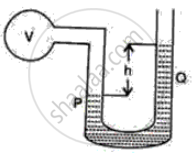Advertisements
Advertisements
Question
Solution
APPEARS IN
RELATED QUESTIONS
Consider the equations `P=lim_(triangles->0)"F"/(triangle"S")` and P1 - P2 = pgz. In an elevator accelerating upward
The areas of pistons in a hydraulic machine are 5 cm2 and 625 cm2. What force on the smaller piston will support a load of 1250 N on the larger piston? State any assumption which you make in your calculation.
The atmospheric pressure at a place is 650 mm of Hg. Calculate this pressure in Pascals (Pa).
The following figure shows a manometer containing a liquid of density p. The limb P of the manometer is connected to a vessel V and the limb Q is open to atmosphere. The difference in the levels of liquid in the two limbs of the manometer is h as shown in the diagram. The atmospheric pressure is P0.
(i) What is the pressure on the liquid surface in the limb Q?
(ii) What is the pressure on the liquid surface in the limb P?

What is the use of altimeter?
Do all liquids exert pressure?
State Pascal’s law.
Match the following:
| 1. | Hydraulic press | a. | Archimedes |
| 2. | Cartesian Diver | b. | Floatation |
| 3. | Hydrostatic Balance | c. | Pascal’s law |
| 4. | Hydrometer | d. | Buoyancy |
